The Evapotranspiration of Tamarix and Its Response to Environmental Factors in Coastal Saline Land of China
Abstract
:1. Introduction
2. Materials and Methods
2.1. Study Site and Plant Species
2.2. Evaporation and Transpiration Measurements
2.3. Environmental Monitoring
2.4. ET0 and VPD Estimates
2.5. Crop Coefficient
2.6. Gray Relational Analysis
2.7. Data Analysis
3. Results
3.1. Observation of Environmental Factors and ET0
3.1.1. Diurnal Dynamics of Environmental Factors and ET0
3.1.2. Variance Analysis of Environmental Factors in Different Years
3.2. Precipitation Distribution and Daily Variation of Soil EC in Different Soil Layers in 2018
3.3. Summary Statistics of Evapotranspiration and Its Components on Tamarix Land and Bare Land
3.4. The Change of Crop Coefficient
3.5. Effects of Environmental Factors on ET and Its Components
3.5.1. Effects of Environmental Factors on Evaporation
3.5.2. Effects of Environmental Factors on Transpiration
3.5.3. Effects of Environmental Factors on Evapotranspiration
3.6. Gray Relational Analyses of the Environmental Factors on ET and Its Components
3.7. The Monthly Distribution of Evaporation, Transpiration, and Precipitation from May to October in 2016, 2017 and 2018
4. Discussion
4.1. Quantifying the ET and Its Components (E and T) of Tamarix
4.2. The Effects of Environmental Factors on the ET
4.3. The Possibility of Vegetation Construction Using Tamarix
5. Conclusions
Author Contributions
Funding
Conflicts of Interest
References
- Yang, J.S. Development and prospect of the research on salt-affected soils in China. Acta Pedol. Sin. 2008, 45, 837–845. [Google Scholar]
- Liu, X. Reclamation and utilization of saline soils in water-scarce regions of Bohai. Chin. J. Eco-Agric. 2018, 26, 1521–1527. [Google Scholar]
- Cui, B.; Yang, Q.; Zhang, K.; Zhao, X.; You, Z. Responses of saltcedar (Tamarix chinensis) to water table depth and soil salinity in the Yellow River Delta, China. Plant Ecol. China 2010, 209, 99–110. [Google Scholar]
- Cao, C.; Jiang, S.; Ying, Z.; Zhang, F.; Han, X. Spatial variability of soil nutrients and microbiological properties after the establishment of leguminous shrub Caragana microphylla Lam. plantation on sand dune in the Horqin Sandy Land of Northeast China. Ecol. Eng. 2011, 37, 1467–1475. [Google Scholar] [CrossRef]
- Xu, H.; Li, Y.; Xu, G.; Zou, T. Ecophysiological response and morphological adjustment of two Central Asian desert shrubs towards variation in summer precipitation. Plant Cell Environ. 2007, 30, 399–409. [Google Scholar] [CrossRef] [PubMed]
- Hultine, K.; Nagler, P.; Morino, K.; Bush, S.; Burtch, K.; Dennison, P.; Glenn, E.; Ehleringer, J.; Dennison, P. Sap flux-scaled transpiration by tamarisk (Tamarix spp.) before, during and after episodic defoliation by the saltcedar leaf beetle (Diorhabda carinulata). Agric. For. Meteorol. 2010, 150, 1467–1475. [Google Scholar] [CrossRef]
- Nippert, J.B.; Butler, J.J., Jr.; Kluitenberg, G.J.; Whittemore, D.O.; Arnold, D.; Spal, S.E.; Ward, J.K. Patterns of Tamarix water use during a record drought. Oecologia 2010, 162, 283–292. [Google Scholar] [CrossRef]
- Zhang, W.J.; Chong, Y.J.; Sheng, S.B.; An, T. Mechanism and measures for improving soil in alkali saline land by use of tamarix chinensis lour. Inn. Mong. For. Sci. Technol. 2003, 4, 3–7. [Google Scholar]
- Feng, X.; An, P.; Li, X.; Guo, K.; Yang, C.; Liu, X. Spatiotemporal heterogeneity of soil water and salinity after establishment of dense-foliage Tamarix chinensis on coastal saline land. Ecol. Eng. 2017, 121, 104–113. [Google Scholar] [CrossRef]
- Sala, A.; Smith, S.D.; Devitt, D.A. Water use by Tamarix ramosissima and associated phreatophytes in a Mojave Desert floodplain. Ecol. Appl. 1996, 6, 888–898. [Google Scholar] [CrossRef]
- Cleverly, J.R.; Dahm, C.N.; Thibault, J.R.; McDonnell, D.E.; Coonrod, J.E.A. Riparian ecohydrology: Regulation of water flux from the ground to the atmosphere in the Middle Rio Grande, New Mexico. Hydrol. Process. 2006, 20, 3207–3225. [Google Scholar] [CrossRef]
- Yu, T.; Qi, F.; Si, J.; Zhang, X.; Zhao, C. Tamarix ramosissima stand evapotranspiration and its association with hydroclimatic factors in an arid region in northwest China. J. Arid Environ. 2017, 138, 18–26. [Google Scholar] [CrossRef]
- Lian, X.; Piao, S.; Huntingford, C.; Li, Y.; Zeng, Z.; Wang, X.; Ciais, P.; McVicar, T.R.; Peng, S.; Ottle, C.; et al. Partitioning global land evapotranspiration using CMIP5 models constrained by observations. Nat. Clim. Chang. 2018, 8, 640–646. [Google Scholar] [CrossRef]
- Nagler, P.L.; Morino, K.; Didan, K.; Erker, J.; Osterberg, J.; Hultine, K.R.; Glenn, E.P. Wide-area estimates of saltcedar (Tamarix spp.) evapotranspiration on the lower Colorado River measured by heat balance and remote sensing methods. Ecohydrology 2009, 2, 18–33. [Google Scholar] [CrossRef]
- Nagler, P.L.; Scott, R.L.; Westenburg, C.; Cleverly, J.R.; Glenn, E.P.; Huete, A.R. Evapotranspiration on western U.S. rivers estimated using the Enhanced Vegetation Index from MODIS and data from eddy covariance and Bowen ratio flux towers. Remote Sens. Environ. 2005, 97, 337–351. [Google Scholar] [CrossRef]
- William, L.H.; Hart, C.R. Water Loss and Salvage in Saltcedar (Tamarix spp.) Stands on the Pecos River, Texas. Invas Plant Sci Mana. 2009, 4, 309–317. [Google Scholar]
- Allen, R.G.; Pereira, L.S.; Smith, M.; Raes, D.; Wright, J.L. FAO-56 Dual Crop Coefficient Method for Estimating Evaporation from Soil and Application Extensions. J. Irrig. Drain. Eng. 2005, 131, 2–13. [Google Scholar] [CrossRef]
- Chen, Y.; Xue, Y.; Hu, Y. How multiple factors control evapotranspiration in North America evergreen needleleaf forests. Sci. Total Environ. 2018, 622, 1217–1224. [Google Scholar] [CrossRef]
- Xu, M.; Wen, X.; Wang, H.; Zhang, W.; Dai, X.; Song, J.; Wang, Y.; Fu, X.; Liu, Y.; Sun, X.; et al. Effects of climatic factors and ecosystem responses on the inter-annual variability of evapotranspiration in a coniferous plantation in subtropical China. PLoS ONE 2014, 9, e85593. [Google Scholar] [CrossRef]
- Irmak, S.; Kabenge, I.; Skaggs, K.E.; Mutiibwa, D. Trend and magnitude of changes in climate variables and reference evapotranspiration over 116-yr period in the Platte River Basin, central Nebraska–USA. J. Hydrol. 2012, 420, 228–244. [Google Scholar] [CrossRef]
- Wu, S.H.; Jansson, P.-E.; Kolari, P. Modeling seasonal course of carbon fluxes and evapotranspiration in response to low temperature and moisture in a boreal Scots pine ecosystem. Ecol. Model. 2011, 222, 3103–3119. [Google Scholar] [CrossRef]
- Han, Y.; Zhang, L.; Wang, C.; Yuan, J.; Wei, H. Dynamic characteristics and influencing factors of actual evapotranspiration in cold wetland. South North. Water Transf. Water Sci. Technol. 2018, 16, 28–34. [Google Scholar]
- Zhao, Y.; Liu, Y.; Li, J.; Liu, X. Spatial and temporal variation of potential evapotranspiration and its sensitivity to meteorological factors in china from 1960 to 2013. Desert Oasis Meteorol. 2018, 12, 1–9. [Google Scholar]
- Daamen, C.C.; Simmonds, L.; Wallace, J.; Laryea, K.; Sivakumar, M. Use of microlysimeters to measure evaporation from sandy soils. Agric. For. Meteorol. 1993, 65, 159–173. [Google Scholar] [CrossRef] [Green Version]
- Sakuratani, T. A Heat Balance Method for Measuring Water Flux in the Stem of Intact Plants. J. Agric. Meteorol. 1981, 37, 9–17. [Google Scholar] [CrossRef]
- Gerdes, G.; Allison, B.E.; Pereira, L.S. Overestimation of soybean crop transpiration by sap flow measurements under field conditions in Central Portugal. Irrig. Sci. 1994, 14, 135–139. [Google Scholar] [CrossRef]
- Ren, D.; Xu, X.; Hao, Y.; Huang, G. Modeling and assessing field irrigation water use in a canal system of Hetao, upper Yellow River basin: Application to maize, sunflower and watermelon. J. Hydrol. 2016, 532, 122–139. [Google Scholar] [CrossRef]
- Allen, R.G. Crop evapotranspiration-Guidelines for computing crop water requirements-FAO Irrigation and drainage paper. Fao Rome 1998, 56, D05109. [Google Scholar]
- Wei, G.H.; Dong, X.N.; Yang, P.N. Study on water surface evaporation forecast based on multivariate linear regression model and gray relational analysis. Water Sav. Irrig. 2010, 2, 41–44. [Google Scholar]
- Blum, A. Effective use of water (EUW) and not water-use efficiency (WUE) is the target of crop yield improvement under drought stress. Field Crop. Res. 2009, 112, 119–123. [Google Scholar] [CrossRef]
- Schlesinger, W.H.; Jasechko, S. Transpiration in the global water cycle. Agric. For. Meteorol. 2014, 189, 115–117. [Google Scholar] [CrossRef]
- Good, S.P.; Noone, D.; Bowen, G. Hydrologic connectivity constrains partitioning of global terrestrial water fluxes. Science 2015, 349, 175–177. [Google Scholar] [CrossRef] [PubMed] [Green Version]
- Mishra, A.; Sharma, S.D.; Khan, G.H. Improvement in physical and chemical properties of sodic soil by 3, 6 and 9 years old plantation of Eucalyptus tereticornis Biorejuvenation of sodic soil. For. Ecol. Manag. 2003, 184, 115–124. [Google Scholar] [CrossRef]
- Lampurlanés, J.; Cantero-Martínez, C. Soil bulk density and penetration resistance under different tillage and crop management systems and their relationship with barley root growth. Agron. J. 2003, 95, 526–536. [Google Scholar]
- Villegas, J.C.; Breshears, D.D.; Zou, C.B.; Law, D.J. Ecohydrological controls of soil evaporation in deciduous drylands: How the hierarchical effects of litter, patch and vegetation mosaic cover interact with phenology and season. J. Arid Environ. 2010, 74, 595–602. [Google Scholar] [CrossRef]
- Yuan, G.; Zhang, P.; Shao, M.-A.; Luo, Y.; Zhu, X. Energy and water exchanges over a riparian Tamarix spp. stand in the lower Tarim River basin under a hyper-arid climate. Agric. For. Meteorol. 2014, 194, 144–154. [Google Scholar] [CrossRef] [Green Version]
- Ren, D.; Xu, X.; Ramos, T.B.; Huang, Q.; Huo, Z.; Huang, G. Modeling and assessing the function and sustainability of natural patches in salt-affected agro-ecosystems: Application to Tamarisk (Tamarix chinensis lour.) in Hetao, upper Yellow River basin. J. Hydrol. 2017, 552, 490–504. [Google Scholar] [CrossRef]
- Yang, Z.; Sinclair, T.R.; Zhu, M.; Messina, C.D.; Cooper, M.; Hammer, G.L. Temperature effect on transpiration response of maize plants to vapour pressure deficit. Environ. Exp. Bot. 2012, 78, 157–162. [Google Scholar] [CrossRef]
- Drake, B.G.; Raschke, K.; Salisbury, F.B. Temperature and Transpiration Resistances of Xanthium Leaves as Affected by Air Temperature, Humidity, and Wind Speed. Plant Physiol. 1970, 46, 324. [Google Scholar] [CrossRef]
- Shah, S.H.H.; Vervoort, R.W.; Suweis, S.; Guswa, A.J.; Rinaldo, A.; van der Zee, S.E.A.T.M. Stochastic modeling of salt accumulation in the root zone due to capillary flux from brackish groundwater. Water Resour. Res. 2011, 47, 27. [Google Scholar] [CrossRef]
- Van der Zee, S.E.A.T.M.; Shah, S.H.H.; Vervoort, R.W. Root zone salinity and sodicity under seasonal rainfall due to feedback of decreasing hydraulic conductivity. Water Resour. Res. 2014, 50, 9432–9446. [Google Scholar] [CrossRef]
- Xu, X.; Huang, G.; Sun, C.; Pereira, L.S.; Ramos, T.B.; Huang, Q.; Hao, Y. Assessing the effects of water table depth on water use, soil salinity and wheat yield: Searching for a target depth for irrigated areas in the upper Yellow River basin. Agric. Water Manag. 2013, 125, 46–60. [Google Scholar] [CrossRef]
- Shokri, N.; Lehmann, P.; Or, D. Liquid phase continuity and solute concentra tion dynamics during evaporation from porous media-pore scale processes near vaporization surface. Phys. Rev. E 2010, 81, 046308. [Google Scholar] [CrossRef] [PubMed]
- Geng, X.; Boufadel, M.C. Impacts of evaporation on subsurface flow and salt accumulation in a tidally influenced beach. Water Resour. Res. 2015, 51, 5547–5565. [Google Scholar] [CrossRef]
- Shokri-Kuehni, S.M.S.; Norouzi Rad, M.; Webb, C.; Shokri, N. Impact of type of salt and ambient conditions on saline water evaporation from porous media. Adv. Water Resour. 2017, 105, 154–161. [Google Scholar] [CrossRef] [Green Version]
- Xu, H.; Li, Y. Water-use strategy of three central asian desert shrubs and their responses to rain pulse events. Plant Soil 2006, 285, 5–17. [Google Scholar] [CrossRef]
- Li, X.; Kang, Y.; Wan, S.; Chen, X.; Chu, L. Reclamation of very heavy coastal saline soil using drip-irrigation with saline water on salt-sensitive plants. Soil Tillage Res. 2015, 146, 159–173. [Google Scholar] [CrossRef]
- Guo, K.; Liu, X. Dynamics of meltwater quality and quantity during saline ice melting and its effects on the infiltration and desalinization of coastal saline soils. Agric. Water Manag. 2014, 139, 1–6. [Google Scholar] [CrossRef]
- Luo, J.; Shen, Y.; Qi, Y.; Zhang, Y.; Xiao, D. Evaluating water conservation effects due to cropping system optimization on the Beijing-Tianjin-Hebei plain, China. Agric. Syst. 2018, 159, 32–41. [Google Scholar] [CrossRef]
- Sun, H.; Zhang, X.; Liu, X.; Liu, X.; Shao, L.; Chen, S.; Wang, J.; Dong, X. Impact of different cropping systems and irrigation schedules on evapotranspiration, grain yield and groundwater level in the North China Plain. Agric. Water Manag. 2019, 211, 202–209. [Google Scholar] [CrossRef]
- Holst, J.; Liu, W.; Zhang, Q.; Doluschitz, R. Crop evapotranspiration, arable cropping systems and water sustainability in southern Hebei, P.R. China. Agric. Water Manag. 2014, 141, 47–54. [Google Scholar] [CrossRef]
- Yang, P.; Hu, H.; Tian, F.; Zhang, Z.; Dai, C. Crop coefficient for cotton under plastic mulch and drip irrigation based on eddy covariance observation in an arid area of northwestern China. Agric. Water Manag. 2016, 171, 21–30. [Google Scholar] [CrossRef] [Green Version]
- Wang, Y.; Zhou, L.; Jia, Q.; Yu, W. Water use efficiency of a rice paddy field in Liaohe Delta, Northeast China. Agric. Water Manag. 2017, 187, 222–231. [Google Scholar] [CrossRef]


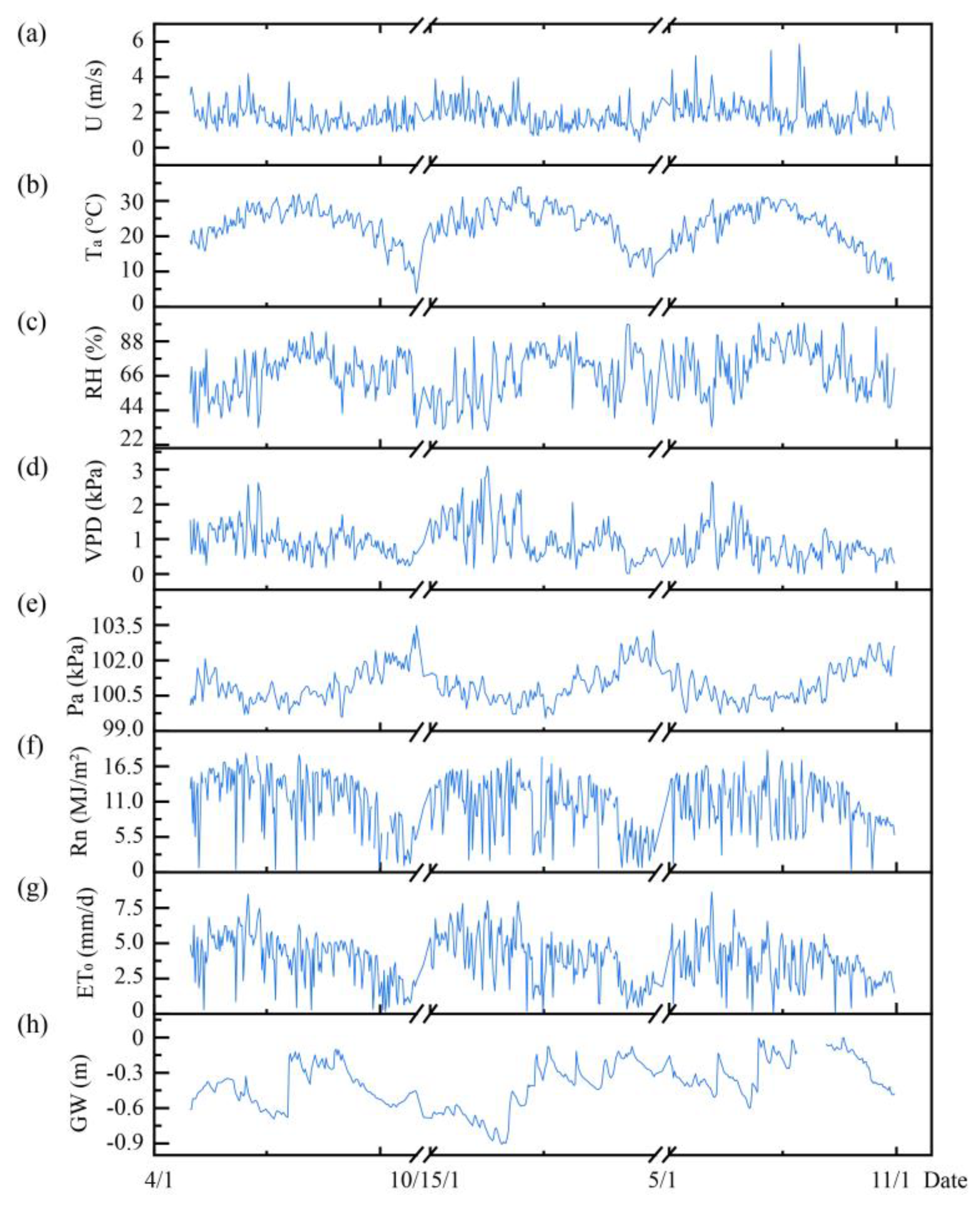
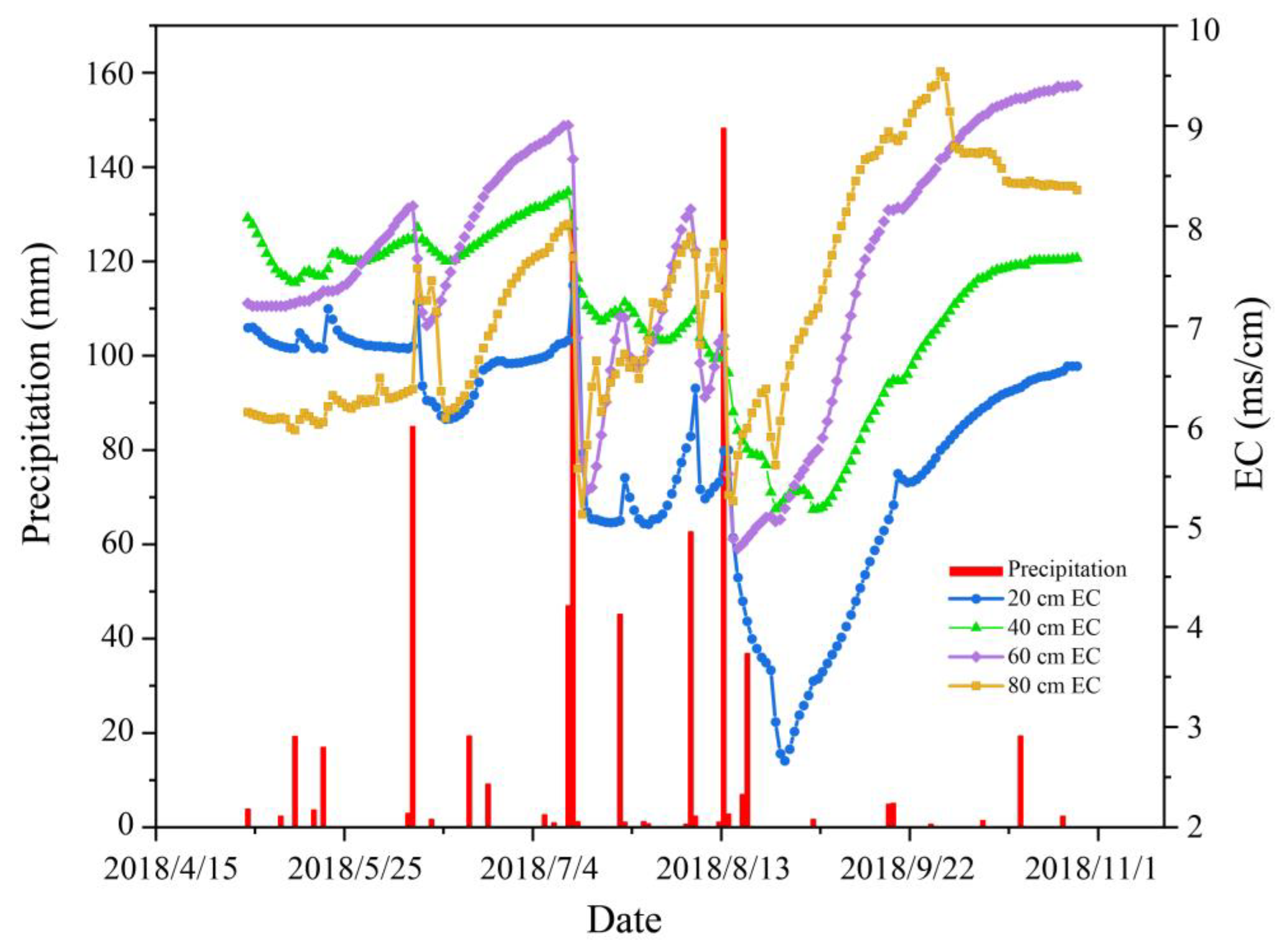
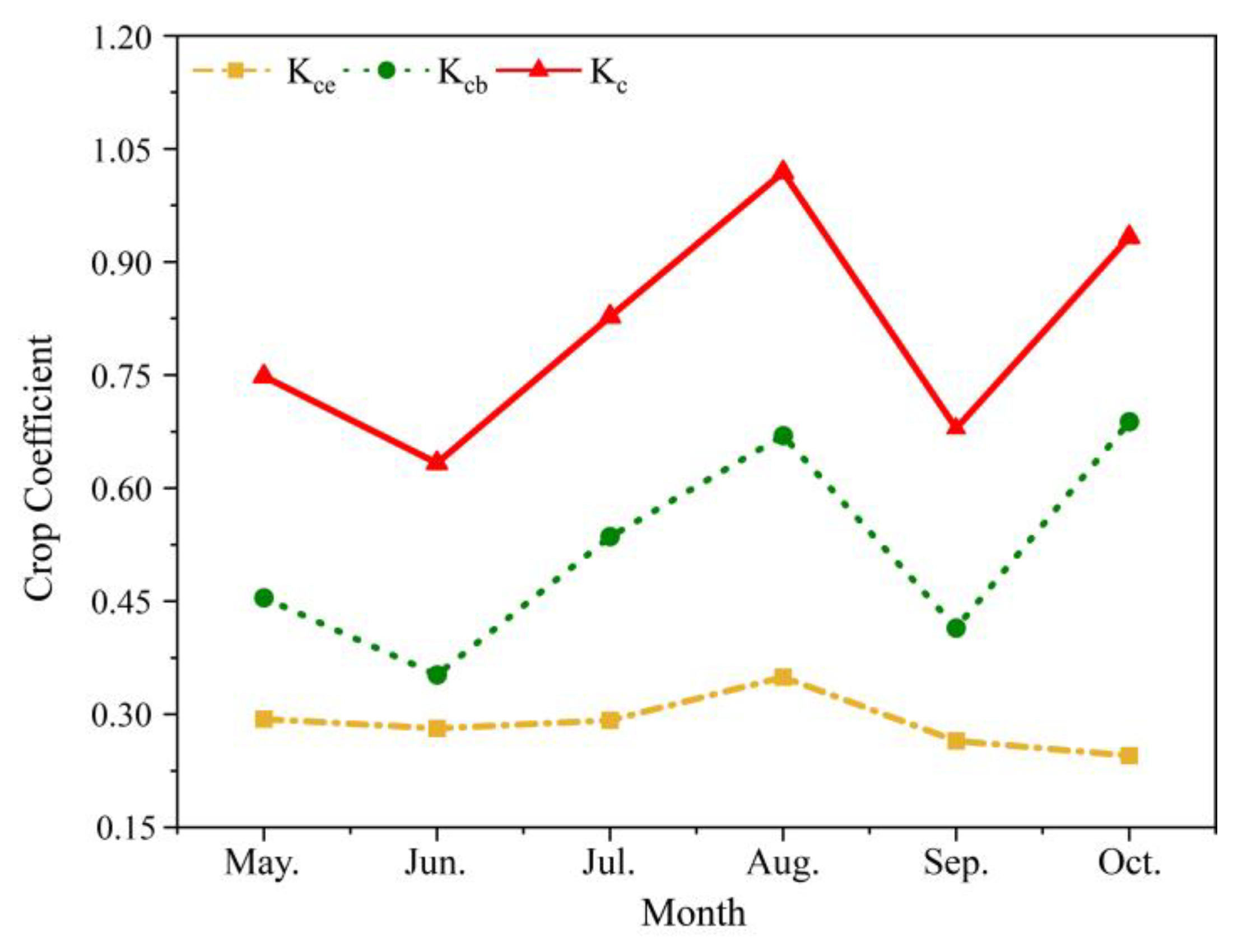
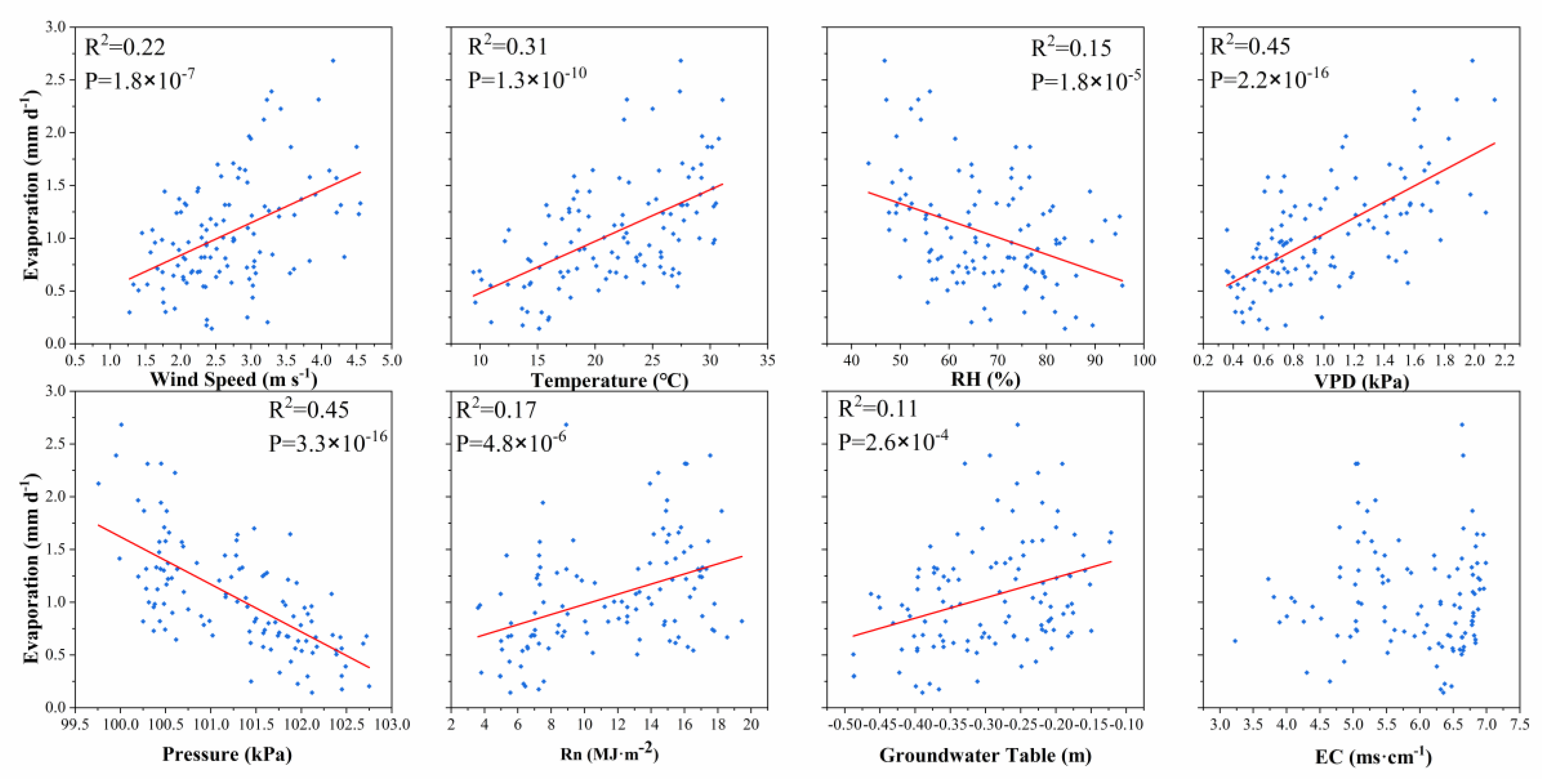


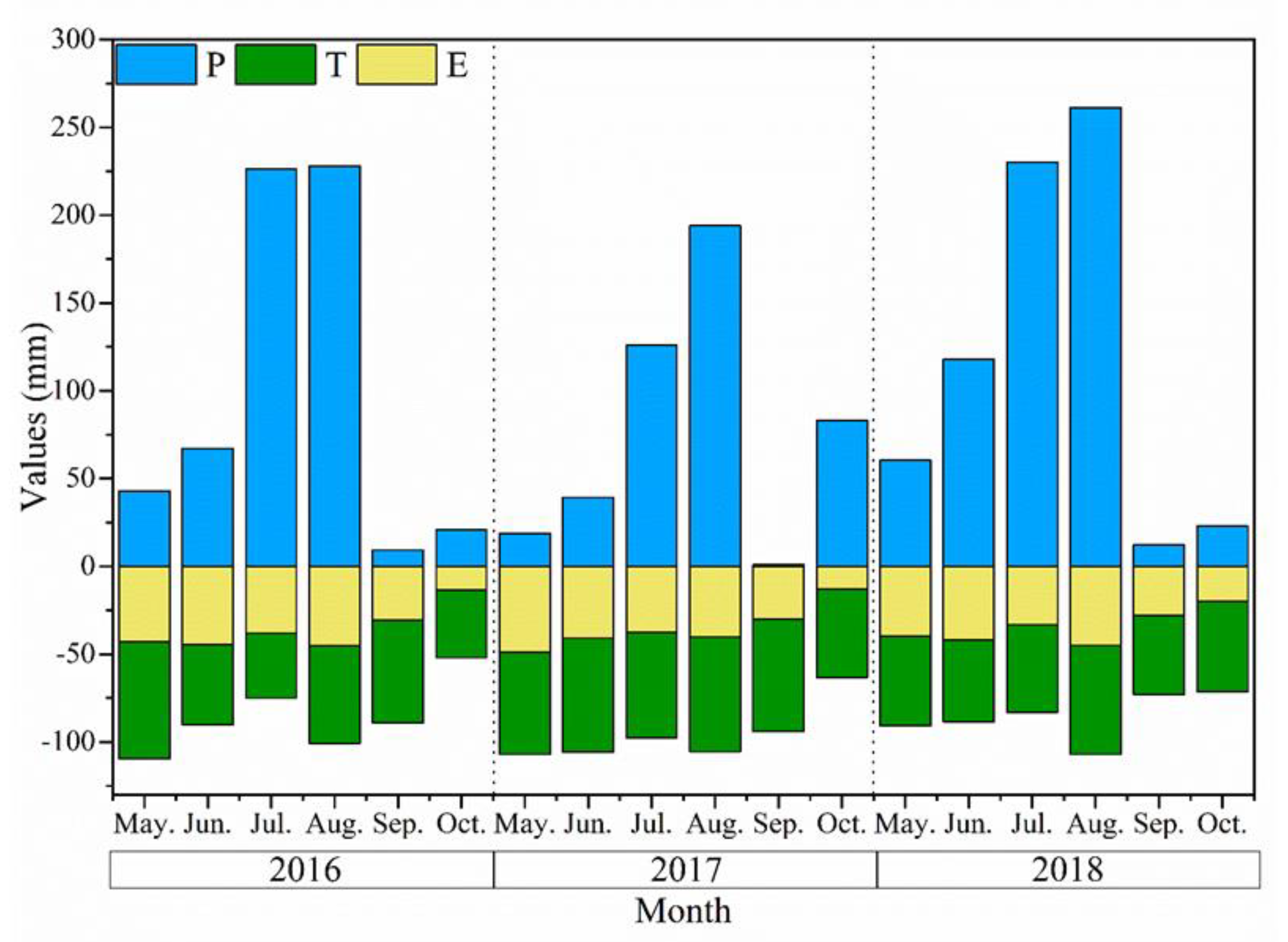
| Soil Layer (cm) | Soil Texture | Bulk Density (g/cm3) | Soil Porosity (%) | Saturated Hydraulic Conductivity (cm/d) | Salt Content (g/kg) | |
|---|---|---|---|---|---|---|
| Bare Land | 0–20 | Silt | 1.60 ± 0.04 | 40 ± 1 | 0.36 ± 0.02 | 38.24 ± 0.03 |
| 20–40 | Silt | 1.56 ± 0.06 | 41 ± 2 | 0.47 ± 0.01 | 8.32 ± 0.04 | |
| 40–60 | Silt | 1.53 ± 0.02 | 42 ± 1 | 0.60 ± 0.02 | 7.10 ± 0.02 | |
| 60–80 | Silt | 1.56 ± 0.03 | 41 ± 1 | 0.48 ± 0.03 | 7.19 ± 0.03 | |
| Tamarix Land | 0–20 | Silt | 1.37 ± 0.02 | 49 ± 1 | 35.45 ± 0.04 | 8.07 ± 0.04 |
| 20–40 | Silt | 1.48 ± 0.03 | 44 ± 1 | 0.61 ± 0.02 | 8.67 ± 0.03 | |
| 40–60 | Silt | 1.54 ± 0.02 | 42 ± 1 | 0.55 ± 0.01 | 8.83 ± 0.02 | |
| 60–80 | Silt | 1.58 ± 0.01 | 40 ± 1 | 0.44 ± 0.03 | 11.37 ± 0.02 |
| Year | U (m/s) | T (°C) | RH (%) | Pa (kPa) | Rn (MJ/m2) | VPD (kPa) | GW (m) |
|---|---|---|---|---|---|---|---|
| 2016 | 1.73 a | 23.29 ab | 67.16 a | 100.95 a | 10.90 a | 0.94 a | −0.51 a |
| 2017 | 1.79 a | 24.01 a | 65.84 a | 100.97 a | 9.81 b | 1.06 b | −0.56 a |
| 2018 | 2.03 b | 22.35 b | 71.88 b | 100.95 a | 10.00 ab | 0.76 c | −0.38 b |
| Month | Eb (mm) | Et (mm) | Etb (mm) | T (mm) | ET (mm) | T/ET |
|---|---|---|---|---|---|---|
| May | 29.7 ± 0.3 | 39.6 ± 0.3 | 57.6 ± 0.5 | 51.3 ± 0.8 | 90.9 ± 1.1 | 56.40% |
| June | 30.0 ± 0.3 | 42.1 ± 0.3 | 61.0 ± 0.3 | 46.3 ± 0.5 | 88.4 ± 0.8 | 52.40% |
| July | 16.2 ± 0.1 | 33.0 ± 0.3 | 50.9 ± 0.8 | 50.3 ± 0.6 | 83.3 ± 0.9 | 60.40% |
| August | 23.9 ± 0.2 | 44.9 ± 0.4 | 64.5 ± 0.6 | 62.1 ± 0.5 | 107.0 ± 0.9 | 58.00% |
| September | 21.8 ± 0.3 | 28.0 ± 0.4 | 39.0 ± 0.4 | 45.0 ± 0.5 | 73.0 ± 0.9 | 61.60% |
| October | 15.0 ± 0.2 | 20.0 ± 0.2 | 28.8 ± 0.3 | 51.6 ± 0.6 | 71.6 ± 0.8 | 72.10% |
| Total | 136.6 ± 1.4 | 207.6 ± 1.9 | 301.9 ± 3.0 | 306.6 ± 3.5 | 514.2 ± 5.4 |
| Correlation Coefficient | ||||||||
|---|---|---|---|---|---|---|---|---|
| X1 | X2 | X3 | X4 | X5 | X6 | X7 | X8 | |
| E | 0.8659 | 0.0929 | 0.3444 | 0.9717 | 0.1374 | 0.6842 | 0.8871 | 0.5182 |
| T | 0.9058 | 0.0926 | 0.3519 | 0.9316 | 0.1374 | 0.7159 | 0.8387 | 0.5369 |
| ET | 0.9294 | 0.0933 | 0.3630 | 0.8600 | 0.1392 | 0.7715 | 0.7746 | 0.5650 |
© 2019 by the authors. Licensee MDPI, Basel, Switzerland. This article is an open access article distributed under the terms and conditions of the Creative Commons Attribution (CC BY) license (http://creativecommons.org/licenses/by/4.0/).
Share and Cite
Chen, H.; Yang, C.; Ren, A.; Guo, K.; Feng, X.; Li, J.; Liu, X.; Sun, H.; Wang, J. The Evapotranspiration of Tamarix and Its Response to Environmental Factors in Coastal Saline Land of China. Water 2019, 11, 2273. https://doi.org/10.3390/w11112273
Chen H, Yang C, Ren A, Guo K, Feng X, Li J, Liu X, Sun H, Wang J. The Evapotranspiration of Tamarix and Its Response to Environmental Factors in Coastal Saline Land of China. Water. 2019; 11(11):2273. https://doi.org/10.3390/w11112273
Chicago/Turabian StyleChen, Huanyu, Ce Yang, Angyan Ren, Kai Guo, Xiaohui Feng, Jingsong Li, Xiaojing Liu, Hongyong Sun, and Jianlin Wang. 2019. "The Evapotranspiration of Tamarix and Its Response to Environmental Factors in Coastal Saline Land of China" Water 11, no. 11: 2273. https://doi.org/10.3390/w11112273
APA StyleChen, H., Yang, C., Ren, A., Guo, K., Feng, X., Li, J., Liu, X., Sun, H., & Wang, J. (2019). The Evapotranspiration of Tamarix and Its Response to Environmental Factors in Coastal Saline Land of China. Water, 11(11), 2273. https://doi.org/10.3390/w11112273






